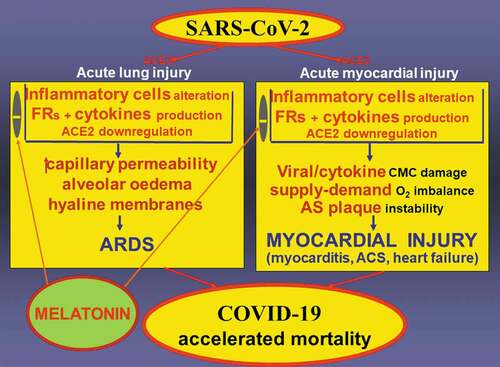Figures & data
Figure 1. SARS-CoV-2 binds to a cell membrane-bound peptidase angiotensin converting enzyme 2 (ACE2), expressed abundantly in the lungs, heart and kidneys, and thus serving as an entrance receptor for the virus. SARS-CoV-2 alters inflammatory cells with subsequent excessive production of cytokines and free radicals (FRs). Binding SARS-CoV-2 to ACE2 associated with ACE2 downregulation, may shift the angiotensin II (Ang) II – Ang 1–7 balance toward the deleterious action of Ang II. Increased capillary permeability, pulmonary edema and hyaline membrane formation in the lungs result in the development of acute respiratory distress syndrome (ARDS). In the heart, direct virus damage or cytokine-induced cardiomyocyte (CMC) injury, hemodynamic stress with an oxygen supply-demand imbalance and inflammation-induced atherosclerotic (AS) plaque instability result in myocardial injury. Both ARDS and myocardial injury contribute to mortality incidence in COVID-19. Melatonin has the potential to reduce oxidative stress, modulate inflammatory cell activation and cytokine release, attenuate endothelial dysfunction and AS plaque instability and improve myocardial energetic metabolism, thereby reducing myocardial injury and fatal outcomes in COVID-19

